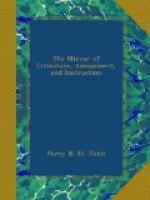Among birds the shell-fish have many enemies. Several of the duck and gull tribes, as you might anticipate, derive at least a portion of their subsistence from them. The pied oyster-catcher receives its name from the circumstance of feeding on oysters and limpets, and its bill is so well adapted to the purpose of forcing asunder the valves of the one, and of raising the other from the rock, that “the Author of Nature,” as Derham says, “seems to have framed it purely for that use.” Several kinds of crows likewise prey upon shell-fish, and the manner in which they force the strong hold of their victims is very remarkable. A friend of Dr. Darwin’s saw above a hundred crows on the northern coast of Ireland, at once, preying upon muscles. Each crow took a muscle up in the air twenty or forty yards high, and let it fall on the stones, and thus broke the shell. Many authorities might be adduced in corroboration of this statement. In Southern Africa so many of the Testacea are consumed by these and other birds, as to have given rise to an opinion that the marine shells found buried in the distant plains, or in the sides of the mountains, have been carried there by their agency, and not, as generally supposed, by eruptions of the sea. Mr. Barrow, who is of this opinion, tells us, in confirmation of it, that “there is scarcely a sheltered cavern in the sides of the mountains that arise immediately from the sea, where living shell-fish may not be found any day of the year. Crows even, and vultures, as well as aquatic birds, detach the shell-fish from the rocks, and mount with them into the air: shells thus carried are said to be frequently found on the very summit even of the Table Mountain. In one cavern at the point of Mussel Bay,” he adds, “I disturbed some thousands of birds, and found as many thousands of living shell-fish scattered on the surface of a heap of shells, that for aught I know, would have filled as many thousand wagons.” The story, therefore, of the ancient philosopher whose bald pate one of these unlucky birds mistook for a stone, and dropped a shell upon it, thereby killing at once both, is not so tramontane as to stumble all belief.
Land shells furnish a few birds with part of their sustenance, and the principal of these are two well known songsters, the blackbird and the thrush. They,
——“whose
notes
Nice finger’d Art must emulate in
vain.”
depend in great measure, when winter has destroyed their summer food, on the more common species of Helices (snails.) These they break very dexterously by reiterated strokes against some stone; and it is not uncommon to find a great quantity of fragments of shells together, as if brought to one particulur stone for this very purpose.—Loudon’s Magazine.
Notes of a Reader
* * * * *
SUSSEX COTTAGES.




